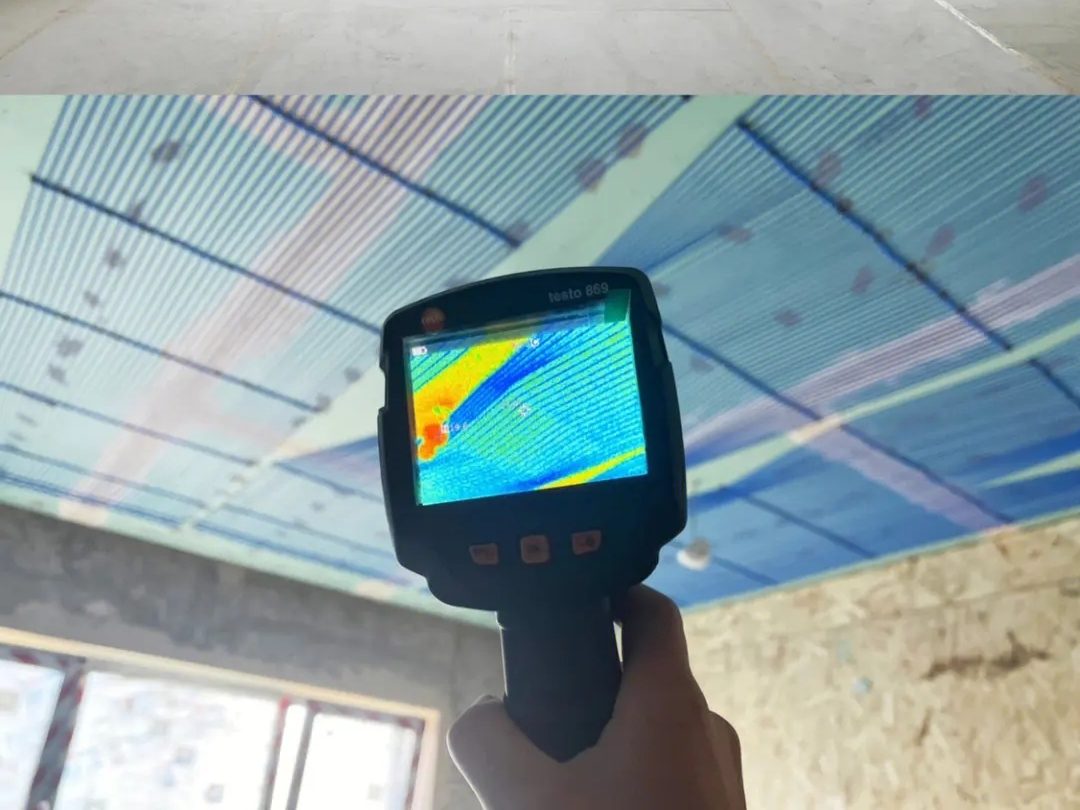HEATING & COOLING SYSTEMS For Capillary tube mats

Thermal camera For Capillary tube mats
HEATING & COOLING Thermal camera For Capillary tube mats
FUNCTIONAL PRINCIPLES AND FEATURES OF SURFACE HEATING AND COOLING SYSTEMS WITH greata CAPILLARY TUBE MATS
greata Capillary Tube Mats are installed directly under the surface of one or several room enclosing surfaces – these can be the ceiling, the walls or the floor.
For heating or cooling spaces, warm or cold water flows through the very thin capillary tubes having outer diameters of 3.4 or 4.3 mm. The surfaces equipped with greata mats are maintained at an even surface temperature. They ensure a quick dissipation of the cooling load or a quick supply of the heat requirement, mainly through radiation and partly through convection.
Due to the large exchange surfaces, considerable amounts of energy can be transferred draught-free and silent even at minor temperature differences between the active room surfaces and the room air.
COOL SPACES WITH Greata CAPILLARY TUBE MATS
For COOLING purposes,greata Capillary Tube Mats are preferentially installed either in or on the ceiling; in this case the surface temperature of the ceiling is, depending on the supply temperature, approx. 19 °C at only 2 to 3 K spreading between supply and return (supply temperature = usually 16 °C; return temperature = 18 °C or 19 °C). Depending on the type of ceiling or the way the capillary tube mats are installed, cooling capacities of up to 100 W/m² (Δ=10 K) can be achieved for closed radiant cooling ceilings.
Surface cooling systems bear the risk of dew point exceedance and of condensation on the cold surface. This risk can be safely ruled out! Therefore each control zone is equipped with one or several dew point sensors. To avoid condensation on the cooling surface, in case of a dew point risk the flow through the capillary tube mats is stopped by closing the control valve. Switching off the individual zones can be counteracted by using an enthalpy-based supply temperature control.
In large and intensively used office buildings cooling ceilings are often combined with a supporting ventilation system, so that dew point exceedance happens very rarely. This is necessary as a rule in order to provide all users with the required fresh air as well as to remove the bad air. The relative humidity is controlled by ventilation and maintained at a comfortable and dew point non-critical range for the users of approx. 50% relative humidity.
Due to the fact that the dissipation of the cooling loads, with this type of system combination, is performed by the cooling ceiling, the air change rate can be reduced to the hygienic minimum necessary (approx. two to three air changes per hour) and the size of the ventilation system can be considerably reduced.
WARM SPACES WITH Greata CAPILLARY TUBE MATS
For HEATING purposes, warm water with a temperature between 22 °C and 36 °C flows through thegreata capillary tube system. In this case, the surface temperature of the ceilings is at approx. 27-30 °C. That way, even during the heating phase, the radiant energy from the user is transferred to the ceiling.
Studies have shown that, when the entire ceiling surface is activated, up to an output of approx. 60-70 W/m², depending on the symmetry in radiation, no losses of comfort are expected when heating by the ceiling.
Higher outputs can be achieved via the floor surface (100 W/m² according to DIN) and the wall surface (130 W/m²), with full comfort.
Due to their considerably larger surface,greata capillary tube mats are much more efficient than conventional systems. This is evident from the fact that they require substantially lower supply temperatures to obtain the same heating capacity. Therefore,greata capillary tube technology is the ideal heat transfer system for heat pumps, whose coefficient of performance increases accordingly. Furthermore,greata capillary tube mats allow the realization of extraordinary low installation heights. For floors e.g. it is possible to apply thegreata capillary tube mats not only in the screed, but also in the thin-layer process directly under the floor covering.
In general,greata Heating and Cooling Systems are considerably more responsive than conventional systems due to the position and geometry of the capillary tubes.
CEILING | COOLING CEILING & CEILING HEATING
A significant area of application forgreata capillary tube mats are thermally activated ceilings, which are often used in large office and administration buildings.
Capillary tube systems have become established throughout Europe, particularly in the segment of cooling ceilings, since the first projects at the end of the 1980s, compared with conventional air conditioning systems. The reasons for this are manifold:
- no negative effects on the health of the users (draughtfree and noiseless) with considerably higher comfort
(radiant cooling system) - significantly lower energy consumption = lower operating costs
- no maintenance required, nevertheless longer system life
- “invisible technology” with drastically reduced space requirements for installation
- environmentally friendly in production, operation and disposal (recyclable PP)
Compared to cooling elements made of copper pipes pressed into heat conducting profiles, plastic capillary tube mats differ mainly insofar that a suspended ceiling construction made of metal or gypsum board is not necessarily required. Due to the small outer diameter of the capillary tubes and their flexibility, capillary tube mats can also be plastered directly onto the bare concrete ceiling – even on curved surfaces!
If the ceiling is also used for heating, a conventional heating system is replaced. This means that thegreata ceiling system can not only be used for cooling, but also for very convenient and energy-efficient heating. Due to low supply temperatures, the ceiling heating system ensures an extraordinary sense of well-being, similar to the principle of solar radiation on the earth’s surface (radiant heating system).


